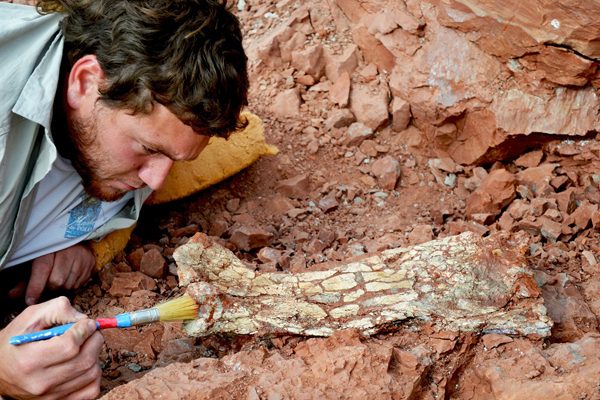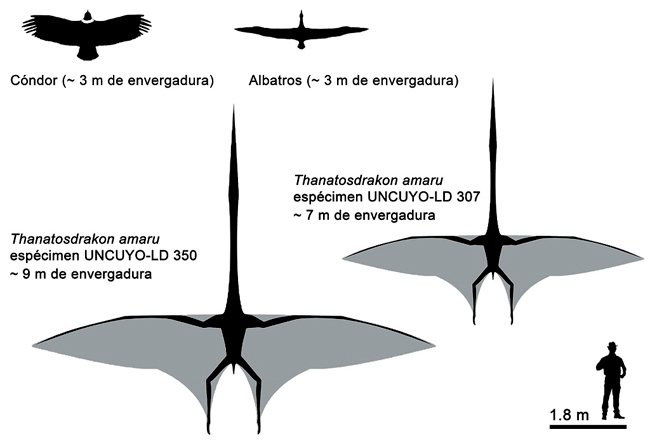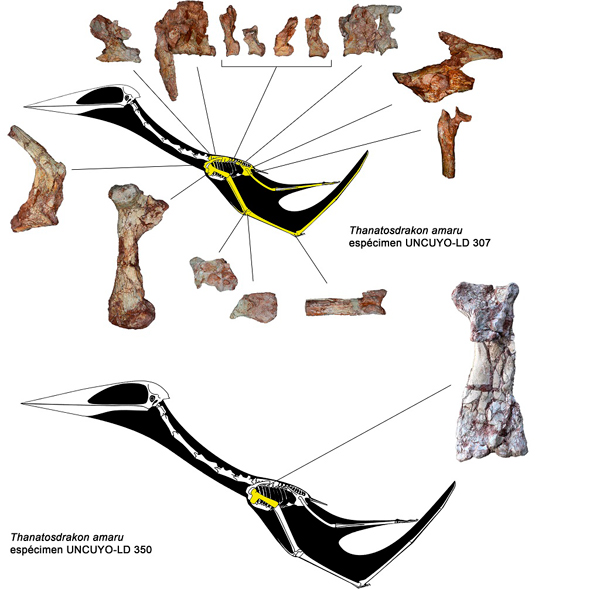Researchers have named the largest pterosaur found to date in South America. The giant Thanatosdrakon (T. amaru) is estimated to have had a wingspan of around nine metres and it would have stood as tall as a giraffe.
Writing in the academic journal “Cretaceous Research”, the scientists, have assigned Thanatosdrakon to the Azhdarchidae family of pterosaurs and postulate that it was closely related to the slightly larger and geologically younger Quetzalcoatlus, fossils of which are known from North America.

One of the Largest Flying Vertebrates Known
The fossil material, thought to represent two individual pterosaurs was found in the upper-most levels of the Plottier Formation (upper Coniacian–lower Santonian, Neuquén Basin), Mendoza, western Argentina. The researchers, who include CONICET* researcher Dr Leonardo Ortiz David, Dr Bernardo González Riga, director of the Laboratory and Museum of Dinosaurs of the Faculty of Exact and Natural Sciences and world-renowned pterosaur expert Dr Alexander Kellner (Director of the National Museum of Rio de Janeiro, Brazil), estimate that Thanatosdrakon lived around 86 million years ago. Based on the single, huge left humerus of the paratype (UNCUYO-LD 350), a wingspan of around 9 metres is proposed, making Thanatosdrakon amaru one of the largest flying vertebrates known to science.

Exceptionally Preserved Fossils
A civil construction project had uncovered some of the fossils. A field team was despatched to map the site and to recover the exceptionally well-preserved bones. The fossil material consists of vertebrae and bones from the limbs. As the larger humerus was found in close proximity to the other fossils, the scientists have speculated that this huge animal was social and probably lived in flocks.
Thanatosdrakon is the oldest taxon of the clade Quetzalcoatlinae so far described. As the strata containing the fossil bones represent deposition in a floodplain environment with ephemeral meandering streams and rivers, the researchers conclude that like the much later Quetzalcoatlus, Thanatosdrakon inhabited continental, inland areas.

Important Information on Azhdarchid Anatomy
The fossils are not distorted or flattened to any great degree. Their three-dimensional preservation will help the researchers to learn more about the anatomy of giant pterosaurs. In addition, some of the fossil bones such as the dorsosacral vertebrae and caudal vertebra along with the notarium (the structure formed by fusion of the dorsal vertebrae, seen in pterosaurs and birds), have never been described in giant azhdarchids. The researchers expect that further study of these bones will provide important information on azhdarchid anatomy.
The “Dragon of Death”
This large pterosaur probably hunted on the ground, perhaps stalking prey in a similar manner to the marabou stork (Leptoptilos crumenifer) which is found in sub-Saharan Africa. The genus name is derived from the Greek words thanatos which means death and drakon (dragon). The species name honours the Inca winged serpent (Amaru).
CONICET* (Consejo Nacional de Investigaciones Científicas y Técnicas [National Council for Scientific and Technical Research of Argentina]).
The scientific paper: “Thanatosdrakon amaru, gen. et sp. nov., a giant azhdarchid pterosaur from the Upper Cretaceous of Argentina” by Leonardo D. Ortiz David, Bernardo J. González Riga and Alexander W. A. Kellner published in the journal Cretaceous Research.






Leave A Comment